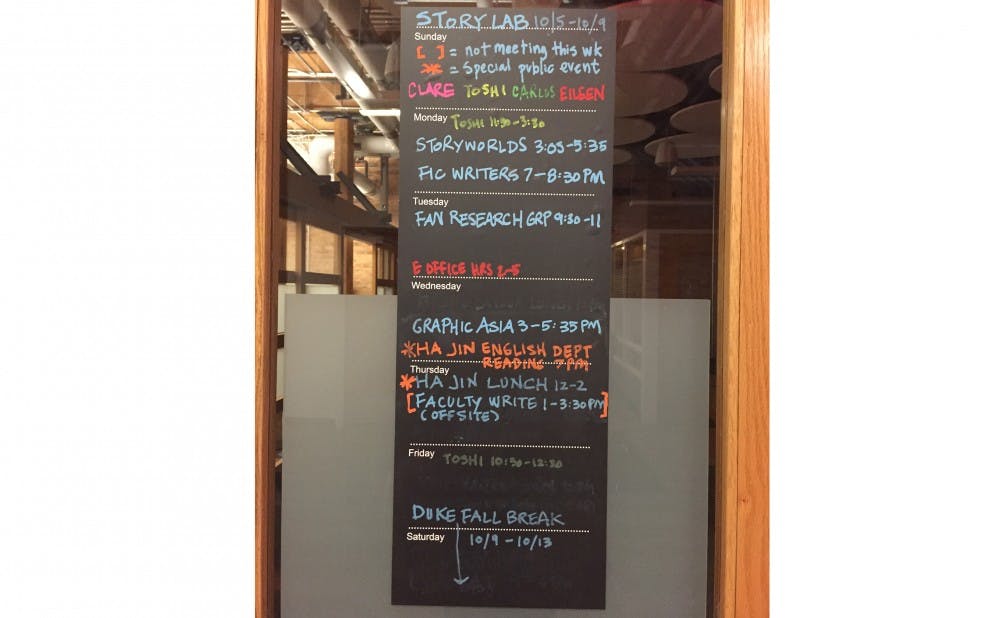Story Lab does not look much like a traditional lab. There are no test tubes, no telescopes, no experimenters in white coats taking exact measurements. Instead, it has long tables arranged seminar-style, a whiteboard and superhero posters on the walls. Story Lab is, in fact, not a traditional lab, but rather part of a new, collaborative approach to humanities research.
Story Lab, still in its first semester, is the newest lab to be established by the Franklin Humanities Institute, funded by the Humanities Writ Large initiative, a five-year Mellon Foundation Grant. The idea for a humanities-based lab was first put into practice at Duke five years ago, with the creation of Haiti Lab. The humanities labs take inspiration for their structure from the familiar set-up of science labs. Labs are, by their very nature, both cooperative and temporary, two traits not often associated with scholarship in the humanities.
"We’re borrowing from the sciences an emphasis on collaboration in order to rethink humanities scholarship," said Story Lab Co-Director Carlos Rojas, associate professor of Chinese Cultural Studies, Women's Studies and Arts of the Moving Image.
The idea for Story Lab came when co-directors Eileen Chow, visiting associate professor of Asian and Middle Eastern Studies, and Clare Woods, associate professor of classical studies, noticed that stories were everywhere and being used in every discipline.
"[We were] trying to develop a lab that could tap into the energy and excitement on the part of undergrads, who are often engaged in narrative activities as part of their spare time but don’t see it as part of their academic studies," Rojas said.
To address the idea of stories from a scholarly perspective, the lab has three research clusters: one on environmental narratives; one on language, stories, and migration; and one on fan communities and fan production.
The cluster focusing on environmental narratives looks at how government policy and popular opinion can be affected by stories. It also examines the role of science fiction as one type of persuasive environmental narrative, and cluster highlights the interdisciplinary nature of the Story Lab by bringing together environmental science, public policy and the study of literature.
“How do you persuade people to save the environment? You use a story,” Chow said.
The storytelling and migration cluster focuses on the ways in which stories move and translate into other languages, looking at issues such as language rights and global English. The lab is partnering with John Hope Franklin scholars to collaborate on a year-long project on the subject of storytelling and migration.
The final cluster is based on the study of fan communities and fan production, especially fan fiction. Storytelling has rarely in history been a solitary activity; the nature of stories involves at least two parties: a storyteller and a listener or reader. The fan production cluster analyzes the ways in which the listeners influence the story.
Chow described the mission of this cluster as studying “the larger ecology of a text.”
The innovative nature of fan production, building new ideas out of existing stories, is a good analogy for the idea behind Story Lab, the synthesis of traditional thoughts on humanities, the model of a sciences lab and the stories we are all engaged in every day.
Examining the effects of fan production, public policy and migration of stories on how scholars think and approach stories is part of what the lab seeks to do, but it is not the entirety of its mission. The lab also seeks to provide a space for creative expression through story. As part of this, the lab hosts a weekly creative writing session Monday evenings at 7:00 pm.
Rojas described the sessions as providing “a semi-structured space to encourage people to write creatively.”
Story Lab also has a variety of other events, including lunch talks given by famous authors. The lab will be hosting an event that will be part Halloween party, part cosplay competition Oct. 30. In November, the lab will be organizing writers participating in National Novel Writing Month—NaNoWriMo—a nation-wide initiative that encourages people to spend the month writing a 40,000 word novel.
As a multifaceted humanities hub, Story Lab aims to be a space for looking at stories from all angles, including academically, creatively and personally.
“The lab is a creative and investigative project built around the idea of story," Rojas said.
Get The Chronicle straight to your inbox
Signup for our weekly newsletter. Cancel at any time.

